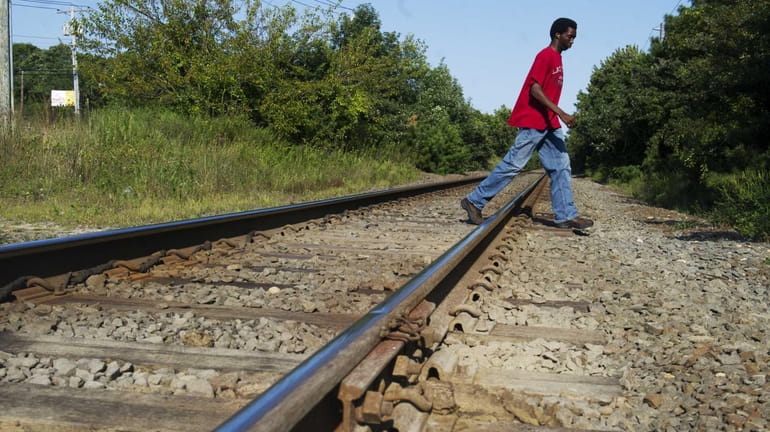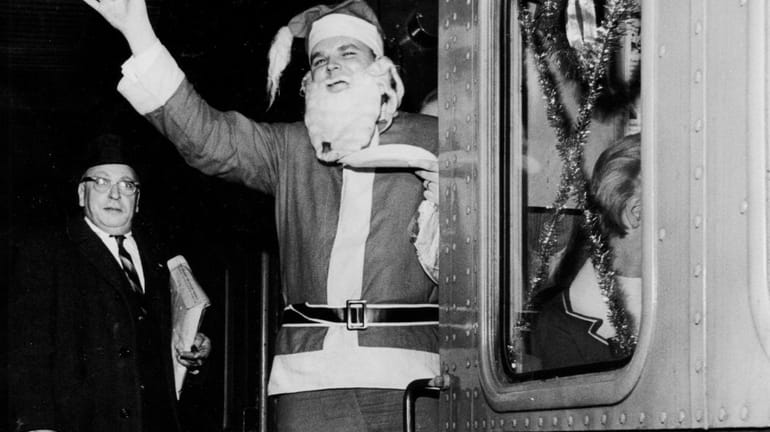LIRR fencing off dangerous trespassing spots along tracks

A pedestrian walks across train tracks at a common crossing in Patchogue on Aug. 29, 2012. Credit: Amanda Voisard
The Long Island Rail Road is stepping up an initiative to fence off dangerous trespassing spots along its tracks.
Last year, 22 people were fatally struck by LIRR trains. Ten of them were deemed suicides. So far this year, 14 people have died on the LIRR's right-of-way. Of those, eight happened in locations away from actual crossings or platforms, and five of those were considered suicides.
The railroad has more than doubled its budget to erect the barriers -- to $8.5 million from $3.1 million -- through 2014, which translates into about three miles of fencing each year.
But some residents say obvious problem sites, including one in Bellport where a 13-year-old boy was hit by a train last year, have been ignored.
Leigh-Anne Peretta, of Holbrook, said she's been asking the LIRR for years to fence off the tracks across the street from her home on Railroad Avenue.
Peretta, 30, said she's used to seeing people walk along the tracks while she waits for the school bus with her two children, ages 6 and 11.
"I stress out about it all the time," she said. "If I catch them [her children] going outside without me, I flip out."
LIRR president Helena Williams said fencing off all 670 miles of railroad property isn't feasible because of the expense and maintenance demands.
"The Long Island Rail Road is an open system, like most railroads in the United States. In many instances, our tracks were there before communities were there," Williams said. "So you start with the philosophy that you know you can't fence it."
Education is not enough
The LIRR focuses its safety efforts on educating the public about the dangers of trespassing onto railroad property, including through its TRACKS (Together Railroads and Children Keeping Safe) program at schools. Trespassing is a misdemeanor punishable by up to three months in jail or a $500 fine.
But LIRR officials "recognize there are locations that we just have to fence," Williams said.
The new fencing segments will vary in length depending on the need at specific sites where pedestrians illegally cross the tracks or walk along them.
"If you go out to these locations, you could see that the dirt has been beat down for so many feet that it [the illegal crossing] must have existed for generations," said Carl Berkowitz, a Moriches railroad safety expert who has called for fencing the entire LIRR system. "This behavior needs to be stopped, and the only way to stop it, unfortunately, is fencing."
Since 2010, the LIRR has installed almost five miles of fencing, officials said. Williams added that the LIRR routinely repairs and replaces existing fencing where it's been pulled down, cut, crushed or otherwise compromised. That work includes a section in Wyandanch where two boys were burned by an electrified third rail when they climbed through a hole in a fence in April.
The LIRR's right-of-way task force, which routinely inspects tracks for dangerous conditions, local police and community leaders determine a list of "priority sites" that need fencing, Williams said.
If trespassing occurs, the LIRR sends a safety team to the location to determine what repairs are needed. In February, the LIRR installed fencing near its Copiague Station after two teenagers climbed onto the tracks and were killed by a train.
Barricades challenged
In some locations, Williams said, fencing has not been erected because communities opposed it as being unsightly.
In 2008, state and Islip Town officials fought an LIRR plan to fence an area in Bayport that the agency said was one of its "highest safety concerns." Then-Islip Town Councilman Chris Bodkin said the fence would be a "scar" in the community. But the LIRR completed the project.
In East Patchogue, near Hewlett Avenue, laborers routinely cross over tracks to walk between a Montauk Highway bus stop and the factory where they work. Train engineers have become so accustomed to trespassers at the site that they sound their horns as they approach.
Jose Rivera, 45, said he uses the shortcut because the nearest legal railroad crossing -- about a quarter mile away at South Country Road -- is too far. "I'd have to go all the way around," Rivera said. "I'm always careful."
Berkowitz, a former engineer with the New York City Transit Authority, said he's investigated several unofficial crossings throughout the LIRR system and found a common link.
"People are going to try to take the shortest distance between two points," he said. "When you have long distances between crossings, then you need a fence . . . if you want to keep the right-of-way safe."
By not fencing the entire system, Berkowitz said, the LIRR could end up paying more than the cost of installation and maintenance in damages awarded in suits stemming from accidents.
The family of Desmond Jones, 14, who was struck in the head by a train as he walked across the tracks near his Bellport home on July 6, 2011, has sued the LIRR. Jones survived, but his attorney, Jason Kessler, of White Plains, said the boy has "cognitive difficulties."
No fencing has been installed at the site at the end of a cul-de-sac where the Jones family lives. Residents said children routinely cross the track to get to and from Montauk Highway. Williams declined to specifically address the Bellport location because the lawsuit is pending.
"There's no fence . . . and kids are just crossing it all the time," Kessler said. "And these trains go by fast."
Others have praised the LIRR for closing off some dangerous locations near tracks. Oceanside Civic Association president Raymond Pagano, who works as a construction consultant to the LIRR, said that about two months after asking for fencing to be installed near the Safe-T Swim school on Lawson Boulevard, an LIRR crew erected about 1,000 feet of fence.
"The children that come to that facility for their swimming lessons could wander or run across the tracks," said Pagano, who added his affiliation with LIRR was not a factor in the site being chosen for fencing. "I would definitely give them [the LIRR] high marks for their response."
Protection praised
The Federal Railroad Administration lauded the LIRR's recent use of 8-foot-tall high-intensity security fencing, made of tightly woven metal, which is difficult to climb or cut through.
Fencing is one option to improve safety, the railroad administration said in a statement, but it also supports better "education, enforcement and engineering" to reduce instances of illegal railroad trespassing, which result in nearly 500 deaths nationally each year.
"The installation of fencing is not a one-size-fits-all proposition," the statement said. "Most fencing cannot prevent trespassers intent on cutting through fences in order to trespass."
But a fence across the street from her home would still be worthwhile, Peretta said. "At least it would deter them," she said of people tempted to cross the tracks. "Right now it's an open invitation."
With Michael Ebert
BY THE NUMBERS
670 Miles of LIRR right-of-way throughout its system
4.8 Miles of fencing installed since 2010
$8.4 million Fencing budget in the LIRR's current 2010-2014 plan
22 People killed on tracks in 2011; 10 ruled suicide
SOURCE: Long Island Rail Road
Updated 58 minutes ago Gilgo-related search continues ... Trump hush money trial latest ... Gang member stands trial ... What's up on LI
Updated 58 minutes ago Gilgo-related search continues ... Trump hush money trial latest ... Gang member stands trial ... What's up on LI

